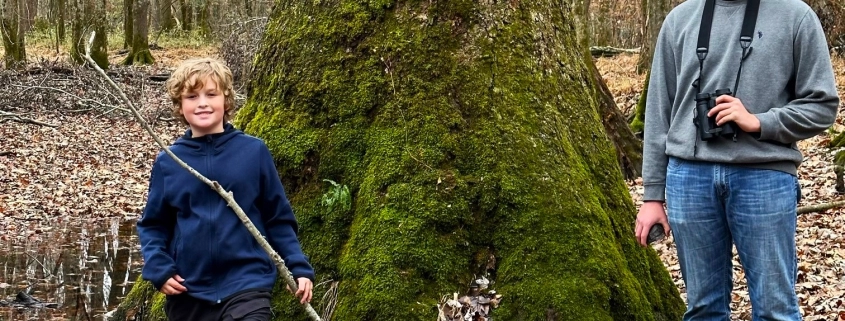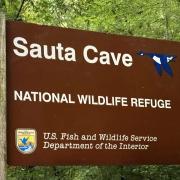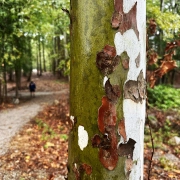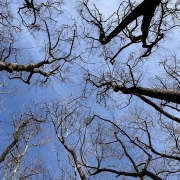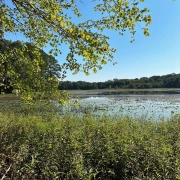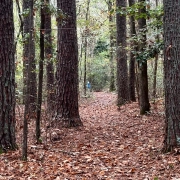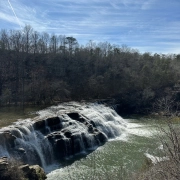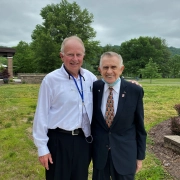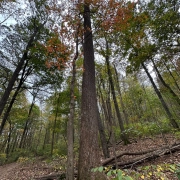Goldsmith-Schiffman Wildlife Sanctuary Exploration with My Alabama Grandsons!
On November 22, 2023, my Alabama grandsons (Jack, age 16, and Sam, age nine) accompanied me to Huntsville, Alabama’s Goldsmith-Schiffman Wildlife Sanctuary. We enjoyed an unusually mild late-November mid-morning through early afternoon, entering from the east side, exploring the riparian hardwood forest, walking along the Flint River shoreline, and visiting the adjacent tupelo swamp. I offer observations, reflections, 27 photos, and four videos.
You can access 26 previous Great Blue Heron Posts from prior trips I’ve made to the Sanctuary. Search Goldsmith under the Blog banner at my website: https://stevejonesgbh.com/
Forest Wonder Potpourri
We discovered a potpourri of forest wonders. I’m grateful any time that the boys come along with me. Their lives and interests will in time diverge from their aging Pap’s. I am pleased that they still appreciate and learn from our forest wanderings. The Sanctuary remains one of our favorite destinations.
I never tire of finding a forest trunk draped in tree moss. This hickory, just 100 feet from the Flint River, evidences our moist temperate climate and its proximity to the morning fogs and heightened humidity along the river.
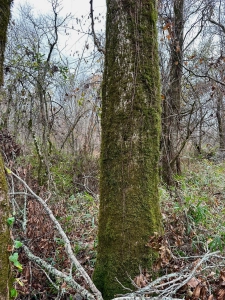
A nearby sugarberry trunk teems with life. Dense tree moss and a Virginia creeper vine adorn the stem below left. At the lower center of the photo at left and up the entire trunk within the photo at right, horizontal rows of yellow bellied sapsucker birdpecks portray a history of woodpecker insect foraging.
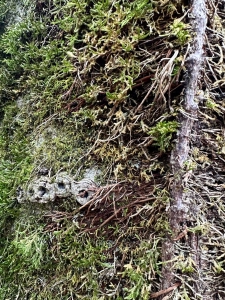
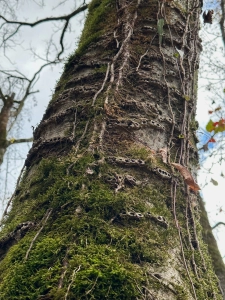
Virginia creeper literally clings to life on this sugarberry tree, its air roots grasping the trunk, assuring lifetime anchorage on its tree trunk lift to the upper canopy rich with direct sun to fuel life-sustaining photosynthesis. It bears repeating that Virginia creeper, wild grapevines, and supplejack do not climb trees. Instead, they grow up with the supporting tree. Imagine this Virginia Creeper germinating beside the sugarberry geminate. The creeper grew vertically at the same rate as the seedling, its leaves with each season remaining in full sunlight.
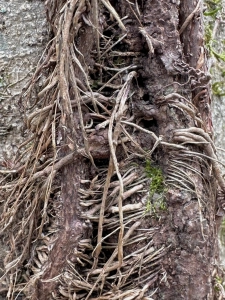
As with many organisms coexisting in Nature, Virginia creeper and sugarberry seem to have achieved some balance. That is, evolutionarily, the creeper has learned not to overgrow and suffocate the tree, for doing so would kill the vine’s highway to the sky. The vine enjoys a direct, full sunlight benefit from the tree. I am unsure of the reciprocal benefit to the tree from providing a lift to the vine. Without exploring the ecological literature for verification, I can only muse that the vine provides cover and access for birds and small mammals that feed on insects that consume sugarberry leaves. The vines might also ensure a canopy microclimate that deters fungi, viral agents, mold, and bacteria potentially harmful to the tree.
I am smitten by the cylindrical sugarberry birdpeck scars. So much of Nature’s beauty, magic, wonder, and awe is hidden in plain sight.
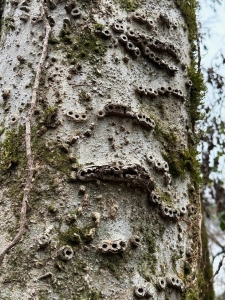
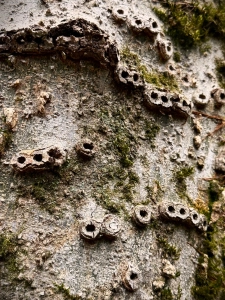
Resurrection fern, no longer in its drought-induced desiccated state, overhhangs the Flint River.
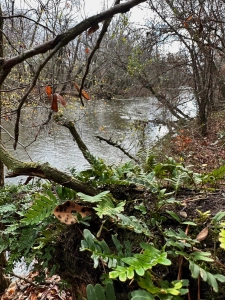
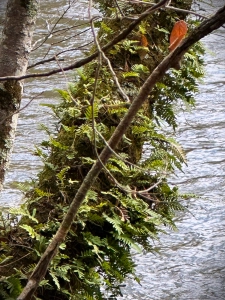
I recorded this 32-second video along the Flint River, amplifying the mood of peace and tranquility:
How can a naturalist not be attracted to such a beauty as this farkleberry (AKA sparkleberry), the largest member of our native blueberries (genus Vaccinium (arboreum)). Even its common names evoke mystery.
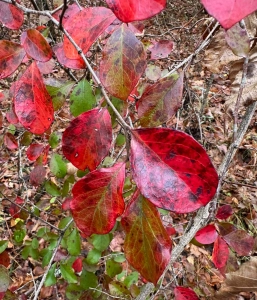
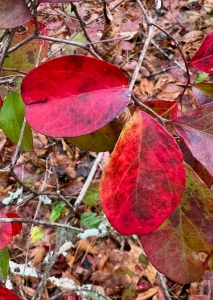
Nearby another handsome shrub drew us closer, a rusty blackhaw. I borrowed this description from an NC State University Extension online reference:
Rusty blackhaw is a deciduous multi-stemmed shrub or small single-stemmed tree in the Viburnaceae (haw) family. It is native to eastern and central USA and is found in most areas of NC growing in rocky or dry woodlands and forests, along streams and valleys. The name comes from the rusty brown hairs on the undersides of leaves, buds and stems.
Rusty blackhaw grows in dry to moist loams in full sun to partial shade slowly reaching a height and width of 10 to 20 feet. Clusters of small, white flowers mature in early spring followed by a blue drupe that matures in fall. The leaves have excellent fall color.
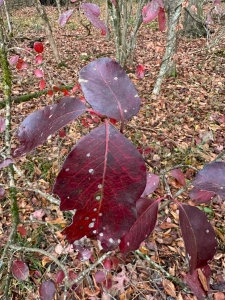
I love the dormant season with full understory visibility, no biting insects, and comfortable temperatures!
Tupelo Swamp
I recorded this 57-second video in the water tupelo swamp on the Sanctuary’s northeast quadrant. Recent rains were just beginning to rewater the swamp.
Tree moss skirts, clinging vines, buttressed trunks, swamp stain lines, and a forest floor bereft of vegetation characterize the Sanctuary’s tupelo stands. I am tempted to refer to these stands as special places, yet I could just as logically term dozens of other elements of the Sanctuary as special places.
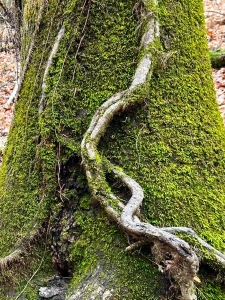
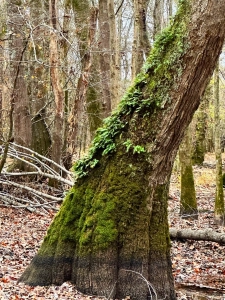
Note the swamp water stain lines (on the tree at left) suggesting normal winter water depth). I wear my calf-high rubber boots when I visit mid-winter.
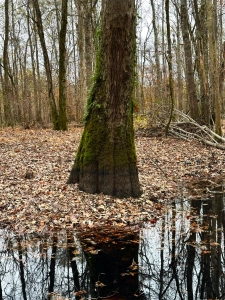
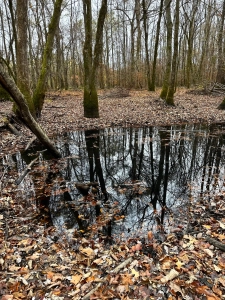
I recorded this 17-second video within the swamp. I am intent on making these grandson forays meaningful, educational, and fun.
I seek to inspire mindful reflection, even as I remain alert to Nature’s reflections. Both of these photographs express the purpose and realization of that goal.
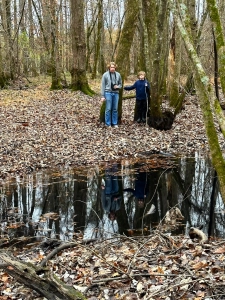
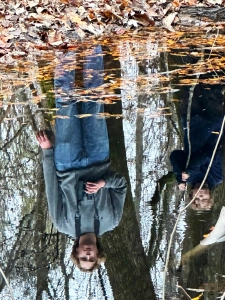
I can’t add anything to the power of this photo essays by adding to the verbal narrative.
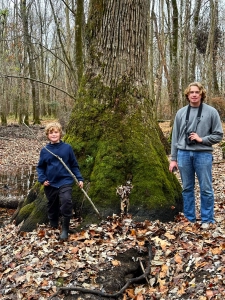
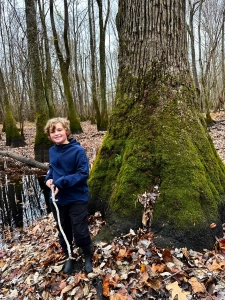
Here’s a 36-second video from the same location.
These graceful swamp residents pose dutifully, seeming intent to reward our visit with their majestic form and rhythm.
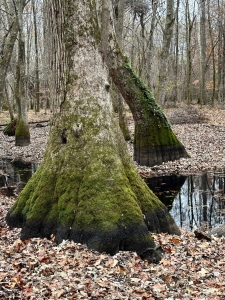
Back to the riparian forest, Sam poses with a hefty supplejack vine. The stem it had once wrapped is long since dead and decayed, leaving only the vine corkscrew. Yellow-bellied sapsucker birdpeck scars encircle the supplejack at right.
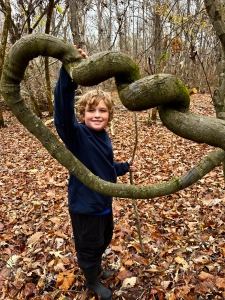
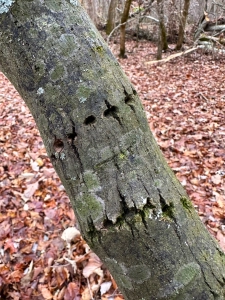
A Few Living Critters!
A mild late fall day, a rough greensnake surprised us, accommodating our disturbance and gentle handling. We anticipated we might see deer or squirrels, but did not expect to see a coldblooded critter. We bid the snake adieu.
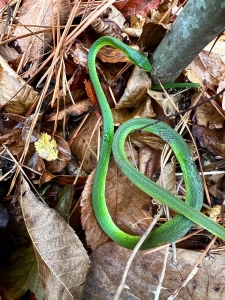
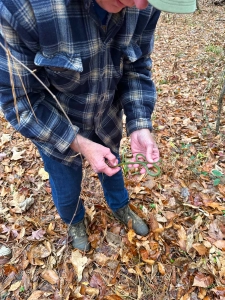
As we examined the snake, I noticed a few still-green pipevine leaves nearby. Knowing the plant’s exclusive hosting relationship to the pipevine swallowtail, I looked more closely, discovering a troop of the butterfly’s caterpillars. Online literature suggests that the larvae will soon form a chrysalis suspended several feet above the ground.
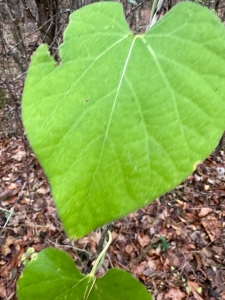
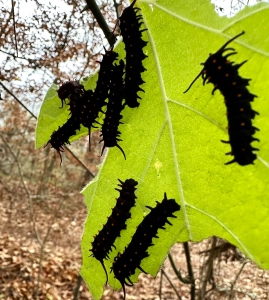
I’ll bring closure with this image of Sam feigning a bite from the fruit (some call it a hedge apple) of an osage orange.
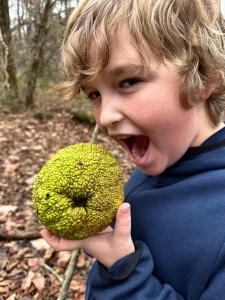
We three boys enjoyed a great morning and early afternoon. I can only hope that they will remember these Nature outings as highlights of their young lives, and that the experiences yield a lasting relationship with Nature.
Thoughts and Reflections
I offer these observations:
- I am intent on making these grandson forays meaningful, educational, and fun.
- I love the dormant season with full understory visibility, no biting insects, and comfortable temperatures!
- The Sanctuary, as do most wild areas of my acquaintance, hosts many special places.
Inhale and absorb Nature’s elixir. May Nature Inspire, Inform, and Reward you!
Note: Unless otherwise noted, all blog post images are created & photographed by Stephen B. Jones. Please circulate images with photo credit: “©2024 Steve Jones, Great Blue Heron LLC. All Rights Reserved.”
Another Note: If you came to this post via a Facebook posting or by another route, please sign up now (no cost… no obligation) to receive my Blog Post email alerts: http://eepurl.com/cKLJdL
And Third: I am available for Nature-Inspired Speaking, Writing, and Consulting — contact me at steve.jones.0524@gmail.com
A reminder of my Personal and Professional Purpose, Passion, and Cause
If only more of us viewed our precious environment through the filters I employ. If only my mission and vision could be multiplied by untold orders of magnitude:
Mission: Employ writing and speaking to educate, inspire, and enable readers and listeners to understand, appreciate, and enjoy Nature… and accept and practice Earth Stewardship.
Vision:
- People of all ages will pay greater attention to and engage more regularly with Nature… and will accept and practice informed and responsible Earth Stewardship.
- They will see their relationship to our natural world with new eyes… and understand their Earth home more clearly.
Tagline/Motto: Steve (Great Blue Heron) encourages and seeks a better tomorrow through Nature-Inspired Living!
Steve’s Three Books
I wrote my books Nature Based Leadership (2016), Nature-Inspired Learning and Leading (2017), and Weaned Seals and Snowy Summits: Stories of Passion for Place and Everyday Nature (2019; co-authored with Dr. Jennifer Wilhoit) to encourage all citizens to recognize and appreciate that every lesson for living, learning, serving, and leading is either written indelibly in or is powerfully inspired by Nature.
I began writing books and Posts for several reasons:
- I love hiking and exploring Nature
- I see images I want to (and do) capture with my trusty iPhone camera
- I enjoy explaining those images — an educator at heart
- I don’t play golf!
- I do love writing — it’s the hobby I never needed when my career consumed me
- Judy suggested my writing is in large measure my legacy to our two kids, our five grandkids, and all the unborn generations beyond
- And finally, perhaps my books and Blogs could reach beyond family and touch a few other lives… sow some seeds for the future
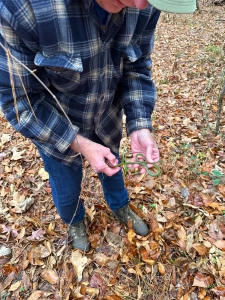
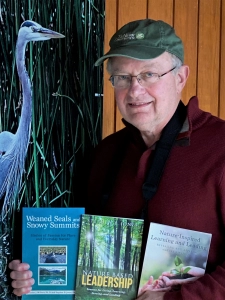
All three of my books (Nature Based Leadership; Nature-Inspired Learning and Leading; Weaned Seals and Snowy Summits) present compilations of personal experiences expressing my (and co-author Dr. Wilhoit for Weaned Seals and Snowy Summits) deep passion for Nature. All three books offer observations and reflections on my relationship with the natural world… and the broader implications for society. Order any from your local indie bookstore, or find them on IndieBound or other online sources such as Amazon and LifeRich.
I now have a fourth book, published by Dutton Land and Cattle Company, Dutton Land & Cattle: A Land Legacy Story. Available for purchase directly from me. Watch for details in a future Post.

